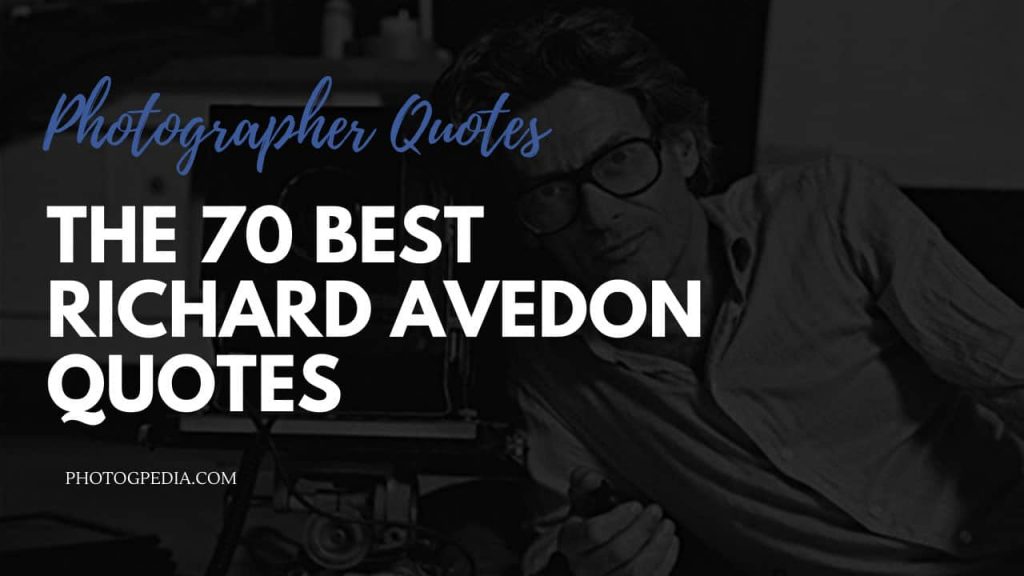Here they are: the 70 best Richard Avedon quotes on photography.
Below we’ve compiled an awesome list of Richard Avedon’s quotes, covering everything from his photographic process to how he shoots his incredible portraits to his thoughts on equipment and much more.
Whether you want some inspiration or you’re looking for words of advice from the best or even if you’re in a creative slump and you want a few ideas to get you out of it, then these quotes should do the trick.
To learn more about the remarkable career of Richard Avedon, then don’t forget to check out our article: Richard Avedon: The Million Dollar Man, which is one of our most popular articles.
Richard Avedon Quotes
Richard Avedon’s Photography Philosophy
I’ve never been able to put all I know into a photograph. A photograph can be an adjective, a phrase. It can even be a sentence or a paragraph, but it can never be a chapter. So, it’s been a lifetime of frustration in terms of expressing myself because of the limitations of the visual image. I believe in it, but it’s limited.
It’s in trying to direct the traffic between Artiface [sic] and Candor, without being run over, that I’m confronted with the questions about photography that matter most to me.
Sometimes I think all my pictures are just pictures of me. My concern is . . . the human predicament; only what I consider the human predicament may simply be my own.
I’m limited. I never felt that there was a single photograph that said everything or even half of what I knew about the subject. You get an aspect of it, you get a certain moment, you can deepen it a certain level, but I really know I can’t get into one picture.
We live in a world of images. Images have replaced language – and reading. The responsibility to your role in history in whatever is going to happen to human beings- you are the new writers. And we can no longer be sloppy with what we do with the camera. You have this weapon in your hands, which is a camera, and it is going to teach the world, it is going to record the world, and it is going to explain to the world and to the children that are coming – what that world was like. It is an incredible responsibility.
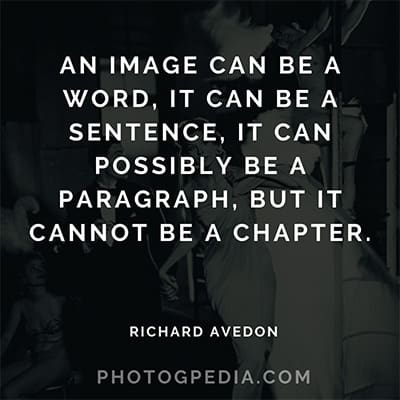
Photography Process
I hate photographs, most photographs. I cannot take a picture of something I have not known and experienced myself, because I do not know what is going on. The photograph is not reportage. I do not believe that something reports itself in a photograph. It is redrawn; it is something I am saying.
When images are too graphic, you lose the emotional thrust.
I am only stimulated by people, never by ideas, almost never. It is always an emotional response. It is always between myself and myself and another person – this is what it boils down to.
There’s nothing hard about photography. I get scared, and I’m longing for the fear to come back. I feel the fear when I have the camera in hand. I’m scared like when an athlete is scared, you’re going for the high jump. You can blow it. That’s what taking a photo is.
I think I do photograph what I’m afraid of. Things I couldn’t deal with… My father’s death, madness, when I was young and women. I didn’t understand. It gave me a sort of control over the situation, which was legitimate because good work was being done. And by photographing what I was afraid of, or what I was interested in – I laid the ghost. It got out of my system and onto the page.
Fashion is about who you want to be, not who you are, it’s therefore artificial… it’s funny and it’s sad and it’s a little crazy. But I would want those elements to be in any photograph I took.
Start with a style and you are in chains, start with an idea and you are free.
Photography Career
If a day goes by without my doing something related to photography, it’s as though I’ve neglected something essential to my existence, as though I had forgotten to wake up. I know that the accident of my being a photographer has made my life possible.
What I like about being older is that I don’t feel I need to prove myself anymore. Like an onion peeling, I don’t go to dinner parties, I don’t work for magazines anymore. What’s unnecessary? What’s important? Doing the work making the work better. Doing the job better than I did before, and the few close friends in the kitchen you get together with. We sit down and talk, really. There is no turning to the left and right – and asking people about random talk.
I believe in maniacs. I believe in type A’s. I believe that you’ve got to love your work so much that it is all you want to do. I believe you must betray your mistress for your work, you betray your wife for your work; I believe that she must betray you for her work. I believe that work is the one thing in the world that never betrays you, that lasts. If I were going to be a politician, if I were going to be a scientist, I would do it every day. I wouldn’t wait for Monday. I don’t believe in weekends. If you’re headed for a life that’s only involved with making money and that you hope for satisfaction somewhere else, you’re headed for a lot of trouble. And whatever replaces vodka when you’re 45 is what you’re going to be doing.
The Work
I think my best work as a body of work is ‘In the American West’. I did the western photos when I was around 60, and I think that — being 60 is different from 30, 40, 50 – you begin to get a sense of your own mortality. I think my aging, the sort of stepping into the last big chapters— was embedded in this body of work. [A] deeper connection to those people who were strangers. Because of my condition of that time.
One man’s fantasy is another man’s job.
I’ve become my own widow. I’m in charge of my archives; I create books, I create exhibitions… but it will be over. And when it’s over then I’ll read and rest and begin to become a photographer again… I hope. My god in the question of being an older man with passion is Matisse, because when one would have thought he had done everything, he got into bed and re-created color and did the most beautiful work of his life, and most modern work of his life. If I can be reborn for the few years that are left to me, it would make me very happy. And if not, I’ll either really go with full force or I’ll stop.
I think when you work as I’ve worked – there’s something I didn’t do something successfully, which is my family life. Marriage. I don’t think you can do it all. I think if you pay that price, that’s not a terrible price. There is no guarantee any family life is going to work out.
I can see myself as a very old man in a terrific wheelchair. Only, I won’t be photographing the tree outside my window, the way Steichen did. I’ll be photographing other old people.
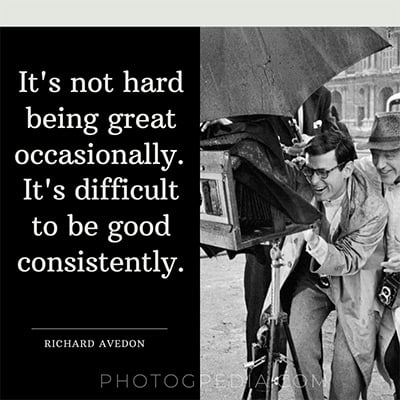
Movement in Photos
Real people move, they bear with them the element of time. It is this fourth dimension of people that I try to capture in a photograph.
When I photograph movement, I have to anticipate that by the time it’s happened, it’s too late to photograph it.
One of the most powerful parts about movement is that it’s a constant surprise. You don’t know what the fabric is going to do, what the hair is going to do, you can control it to a certain degree and then there’s a surprise.
Richard Avedon Quotes on Locations
I always prefer to work in the studio. It isolates people from their environment. They become in a sense… symbolic of themselves.
So, I took my own models out to the beach. I photographed them barefoot, without gloves, running along the beach on stilts, playing leapfrog. When the pictures came in, Brodovitch laid them out on the table and the fashion editor said, ‘these can’t be published. These girls are barefoot.’ Brodovitch printed them. After that, I was launched very quickly. Those candid snapshots were in direct contrast to what was being done. I came in at a time when there weren’t any young photographers working in a freeway. Everyone was tired, the war was over, Dior let the skirts down, and suddenly everything was fun. It was historically a marvelous moment for a fashion photographer to begin. I think if I were starting today, it would be much harder.
Richard Avedon Quotes on Portraits
A photographic portrait is a picture of someone who knows he’s being photographed, and what he does with this knowledge is as much a part of the photograph as what he’s wearing or how he looks. He’s implicated in what’s happened, and he has a certain real power over the result.
When I do a portrait, I have many choices, to be completely subjective, balance subjectivity with objectivity or completely objective.
I think I’m sort of a reader – I used to love handwriting analysis. But that’s nothing compared to reading a face. I think if I had decided to go into the fortune-telling business, I would have probably been very good. What happens to me in work – I look for something in a face, and I look for contradiction, complexity. Somethings that are contradictory and yet connected.
A portrait photographer depends upon another person to complete his picture. The subject imagined, which in a sense is me, must be discovered in someone else willing to take part in a fiction he cannot possibly know about.
I am not necessarily interested in the secret of a person. The fact that there are qualities a subject doesn’t want me to observe is an interesting fact. Interesting enough for a portrait. It then becomes a portrait of someone who doesn’t want something to show. That is interesting.
A portrait isn’t a fact but an opinion – an occasion rather than a truth.
Photographing the Surface
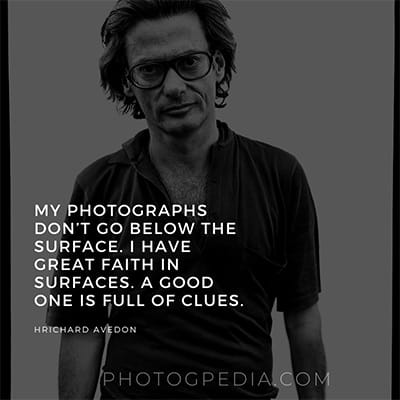
My photographs don’t go below the surface. They don’t go below anything. They’re readings of the surface. I have great faith in surfaces. A good one is full of clues. But whenever I become absorbed in the beauty of a face, in the excellence of a single feature, I feel I’ve lost what’s really there… been seduced by someone else’s standard of beauty or by the sitter’s own idea of the best in him. That’s not usually the best. So, each sitting becomes a contest.
When you pose for a photograph, it’s behind a smile that isn’t yours. You are angry and hungry and alive. What I value in you is that intensity. I want to make portraits as intense as people.
You can’t get at the thing itself, the real nature of the sitter, by stripping away the surface. You can only get beyond the surface by working with the surface. All that you can do is manipulate that surface – gesture, costume, expression – radically and correctly.
The Life of a Photo
I often feel that people come to me to be photographed as they would go to a doctor or a fortune-teller–to find out how they are. So, they’re dependent on me. I have to engage them. Otherwise, there’s nothing to photograph. The concentration has to come from me and involve them. Sometimes the force of it grows so strong that sounds in the studio go unheard. Time stops. We share a brief, intense intimacy. But it’s unearned. It has no past… no future. And when the sitting is over – when the picture is done – there’s nothing left except the photograph…the photograph and a kind of embarrassment. They leave… and I don’t know them.
I’ve hardly heard what they’ve said. If I meet them a week later in a room somewhere, I expect they won’t recognize me. Because I don’t feel I was really there. At least the part of me that was is now in the photograph. And the photographs have a reality for me that the people don’t. It’s through the photographs that I know them.
I don’t really remember the day when I stood behind my camera with Henry Kissinger on the other side. I am sure he doesn’t remember it either. But this photograph is here now to prove that no amount of kindness on my part could make this photograph mean exactly what he.. or even I.. wanted it to mean. It’s a reminder of the wonder and terror that is a photograph
The thing that has happened to me lately is the sense I didn’t take the photos. That they have a life of their own. It’s endlessly mysterious to me.
Subjects Liking the Work
And he said, “I hate that picture. It doesn’t look like me.” Well, for a very smart man to think that a picture is supposed to look like him… would you go to Modigliani and say, “I want it to look like me?”
There are times when it is necessary to trick the sitter into what you want. but never for the sake of the trick.
It is complicated and unresolved in my mind because I believe in the moral responsibility of all kinds. I feel I have no right to say, “This is the way it is” and in another way, I can’t help myself. It is for me the only way to breathe and to live. I could say it is the nature of art to make such assumptions but there has never been an art like photography before. You cannot make a photograph of a person without that person’s presence, and that very presence implies truth.
The photographer has complete control, the issue is a moral one and it is complicated. Everyone comes to the camera with a certain expectation and the deception on my part is that I might appear to be indeed part of their expectation. If you are painted or written about, you can say: but that’s not me, that’s Bacon, that’s Soutine; that’s not me, that’s Celine.
Richard Avedon Quotes On The Truth
There is no truth in photography. There is no truth about anyone’s person. My portraits are much more about me than they are about the people I photograph. I used to think that it was a collaboration, that it was something that happened as a result of what the subject wanted to project and what the photographer wanted to photograph. I no longer think it is that at all.
The photographer has complete control, the issue is a moral one and it is complicated. Everyone comes to the camera with a certain expectation and the deception on my part is that I might appear to be indeed part of their expectation.
I don’t attempt to make a statement about each person as an individual. I’m always more interested in what my feeling is about just living.
I strongly voice my emotions in my photographs … this is a composite portrait of the power elite, but I feel nothing at all for the majority of these people.
I began trying to create an out-of-focus world – a heightened reality, better than real, that suggests, rather than tells you. Maybe the fact that I’m myopic had something to do with it. When I take off my glasses, especially on rainy nights, I get a far more beautiful view of the world than twenty-twenty people get. I wanted to reproduce this more poetic image that I was privately enjoying.
How many pictures have you torn up because you hate them? What ends up in your scrapbook? The pictures where you look like a good guy and a good family man, and the children look adorable – and they’re screaming the next minute. I’ve never seen a family album of screaming people.
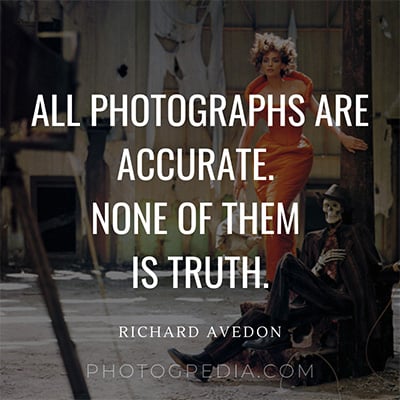
Fiction and Storytelling
[The] Camera lies all the time. It’s all it does is lie, because when you choose this moment instead of this moment, when you… the moment you’ve made a choice, you’re lying about something larger. Lying is an ugly word. I don’t mean lying. But any artist picks and chooses what they want to paint or write about or say. Photographers are the same.
We all perform. It’s what we do for each other all the time, deliberately or unintentionally. It’s a way of telling about ourselves in the hope of being recognized as what we’d like to be. I trust performances. Stripping them away doesn’t necessarily get you closer to anything. The way someone who’s being photographed presents himself to the camera and the effect of the photographer’s response on that presence is what the making of a portrait is about.
When I was a boy, my family took great care with our snapshots. We really planned them. We made compositions. We posed in front of expensive cars, homes, that weren’t ours. We borrowed dogs. Almost every family picture taken of us when I was young had a different borrowed dog in it.
I think the larger issue is that photography is not reportage, it is not journalism – it is fiction. When I go to the west and do the working class (it is more about the working class than the west) – it is my view. Like John Wayne is Hollywood’s view. So, it means my idea of the working class is a fiction.
Beauty and Models
I liked girls who were full of imagination and fun. I loved watching them move, I wasn’t interested in fashion but in making images that reflected a burst of energy and joy.
Beauty can be as isolating as genius or deformity. I have always been aware of the relationship between madness and beauty.
I’m looking for people who are surprising, heartbreaking or beautiful in a terrifying way; beauty that may scare you to death until you acknowledge it as a part of yourself.
First of all, a model has to have the perfect ability to show clothes and then for me, there has to be the complexities and the things I know about that have the things I know about, which have to do with the layering of what it is to be a beautiful woman: the vulnerability, the isolation.
Youth never moves me. I seldom see anything very beautiful in a young face. I do, though – – in the downward curve of Maugham’s lips, in Isak Dinesen’s hands. So much has been written there, there is so much to be read if one could only read. I feel most of the people in my book, Observations, are earthly saints. Because they are obsessed, obsessed with work of one sort or another. To dance, to be beautiful, tell stories, solve riddles, perform in the street. Zavattini’s mouth and Escudero’s eyes, the smile of Marie-Louise Bousquet: they are sermons on bravado.
I’ve tried to get rid of the artificiality of women seen as ideas and to transform them into real women who go into shops, walk down the street, and cry on the underground.
Photography as Art
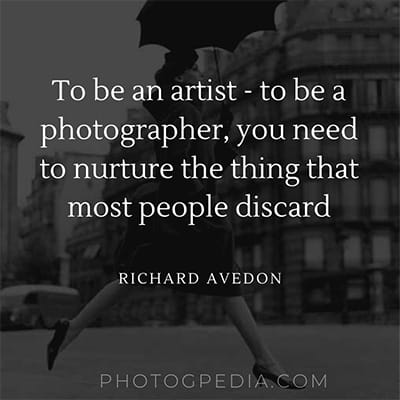
To be an artist – to be a photographer, you need to nurture the thing that most people discard… You have to keep them alive in order to tap them. It’s been important my entire life not to let go of anything which most people would throw in the ashcan. I need to be in touch with my fragility, the man in me, the woman in me. The child in me. The grandfather in me. All these things, they need to be kept alive.
I think all art is about control – the encounter between control and the uncontrollable.
Photography has always reminded me of the second child… trying to prove itself. The fact that it wasn’t really considered an art… that it was considered a craft… has trapped almost every serious photographer.
Anything is an art if you do it at the level of an art.
I never wanted to be called an artist. I wanted to be called a photographer.
It’s just strange to me that anyone would ever think that a work of art shouldn’t be disturbing or shouldn’t be invasive. I mean, that’s the property of a work of art, that’s the arena of a work of art is to disturb, to make you think, to make you feel. If my work didn’t disturb from time to time, it would be a failure in my own eyes. It’s meant to disturb – in a positive way.
On Equipment
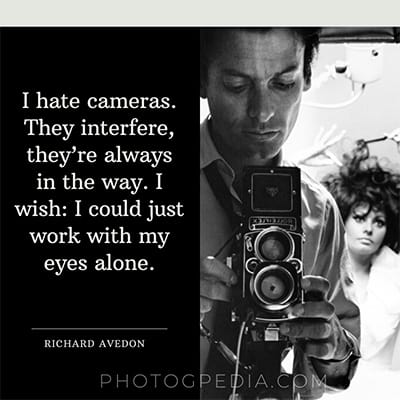
I am not interested in the technique of photography or camera. I am not interested in light. What I want is light in which the subject is free to move in any way without falling into an ugly light. So that I can get to them, to the expression they make, so that they are free to do or express something which is the way I feel.
The camera mostly [gets] in the way. If I could do what I want with my eyes alone, I would be happy. Then when I get it on paper, on the negative, if there was something in the eyes when I took the picture, then when I look at the print, there are things that I can do to emphasize that. But when I’m used to an approach, it becomes like a person that I have no response to.
To get a satisfactory print, one that contains all that you intended, is very often more difficult and dangerous than the sitting itself. When I’m photographing, I immediately know when I’ve got the image I really want. But to get the image out of the camera and into the open is another matter.
Richard Avedon Quotes Final Words
Which of these Richard Avedon quotes was your favorite? Let us know in the comment section below!
By the way, if you haven’t done so already then we recommend reading our: Richard Avedon: The Million Dollar Man article to learn more about the legendary photographer and his incredible career. Also, be sure to visit the Richard Avedon Foundation website.

